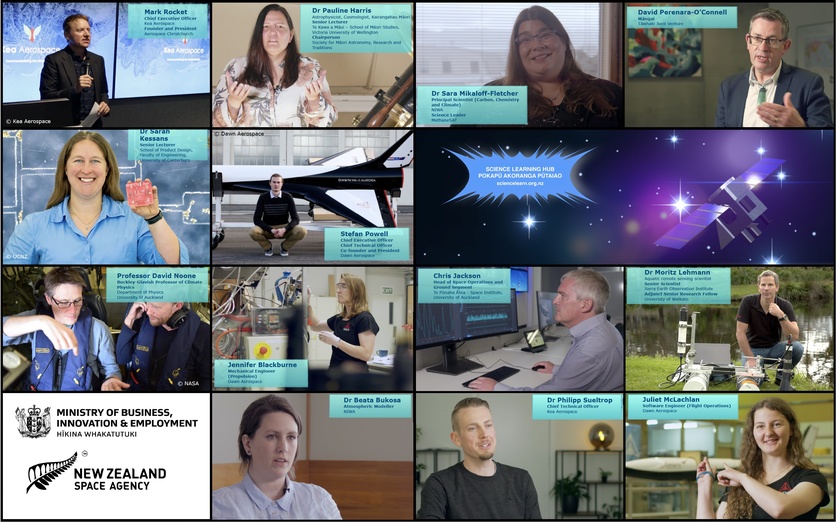If you think that space is vast, wait until you see our newest suite of resources: Aotearoa New Zealand in space! Created for the middle years, there’s something for everyone. The resources are grouped under four broad categories.
Tātai arorangi – cosmological origins
Space has always played a significant role in Aotearoa – space has a complex and extensive whakapapa. Tātai arorangi enabled Māori to navigate the Pacific ocean and develop maramataka specific to Aotearoa New Zealand. Kairangahau Māori (SMART) are preserving and revitalising this knowledge. Celestial knowledge underpins Tāwhaki – a unique collaboration to restore ecosystems while promoting aerospace opportunities.
Satellites – Earth observation
The use of satellites for remote sensing creates science-based solutions for environmental issues. MethaneSAT is Aotearoa New Zealand’s first government-funded space mission. This international collaboration is a game changer in that it can both measure greenhouse gas emissions and track them back to the source. Mission control is operated by Te Pūnaha Ātea – Space Institute, University of Auckland and a separate Kiwi science team leads the mission to measure agricultural emissions.
Remote sensing is also useful for gathering data about water quality, finding ships involved in illegal activities, tracking albatross populations and monitoring tiny movements in the Earth’s tectonic plates.
How do satellites actually work? Get hands-on by building a satellite for a specific mission. This activity uses an awesome interactive simulation. You can also build an actual 3D model of the satellite! Get minds-on and use the science capabilities to analyse real data that the satellite collects, learn strategies to interpret vibrant NASA images or determine if satellite images of your school tell the whole story!
Innovation – ingenuity and sustainability
Aotearoa New Zealand’s aerospace industry is growing all of the time. For example, innovative companies are building reusable aircraft to carry out remote sensing or to launch small satellites – like CubeSats that contain tiny research labs. Rocket Lab recently launched CAPSTONE – a microwave oven-sized CubeSat – that is part of NASA’s mission to return humans to the Moon.
Students can use digital technologies to make a model CubeSat and use micro:bit to work as a sunsensor. Alternatively, they can use micro:bit to create their own space-related project.
Sustainability is also a key driver in aerospace. Space debris is a wicked problem and Kiwis have put their hands up to help deal with it. Encourage students to use Scratch to design a game or interactive model to remove space junk. Sustainability can also be a key factor when students create a space treaty to consider how space is used, by whom and when.
Wawata – seeing ourselves in space
For Aotearoa New Zealand’s space industry to continue to grow, we need young people to take on the challenge. Working in the space sector highlights the breadth of opportunities available. The activity Can I work in the space industry? uses visual literacies to foster aspirational, blue-sky thinking about future careers.
Future writers and filmmakers may enjoy Filming Aotearoa’s space sector to get a behind-the-scenes look at how science content is created.
Pedagogical help
Aotearoa in space can form rich real-life contexts for developing students’ thinking, visioning and problem-solving skills and an array of key competencies. This PLD article provides curriculum information and other pedagogical information to help you get started. We will also have a free PLD webinar with lots of ideas on how to use these resources in your classroom. Mark your calendars for 22 September.
Follow us
We offer support and connections across both education and science sectors through our social media. We welcome Greta, our superstar PLD facilitator, to her new role with social media! Haere rā to Rachel, who is passing over the reins after nearly a decade of tweets and posts, to focus on creating more amazing multimedia content for the Hub.
Contact us about creating collections or boards tailored to your needs. We can help foster connections between the education and science communities.
- Facebook: www.facebook.com/nzsciencelearn
- Twitter: www.twitter.com/NZScienceLearn
- Pinterest: nz.pinterest.com/nzsciencelearn
- Instagram: www.instagram.com/sciencelearninghubnz
Your feedback
We hope you enjoy using the Science Learning Hub – Pokapū Akoranga Pūtaiao in your teaching and would love to hear from you. Your comments, ideas and feedback can be emailed to enquiries@sciencelearn.org.nz.
Noho ora mai
Science Learning Hub – Pokapū Akoranga Pūtaiao
See all news


